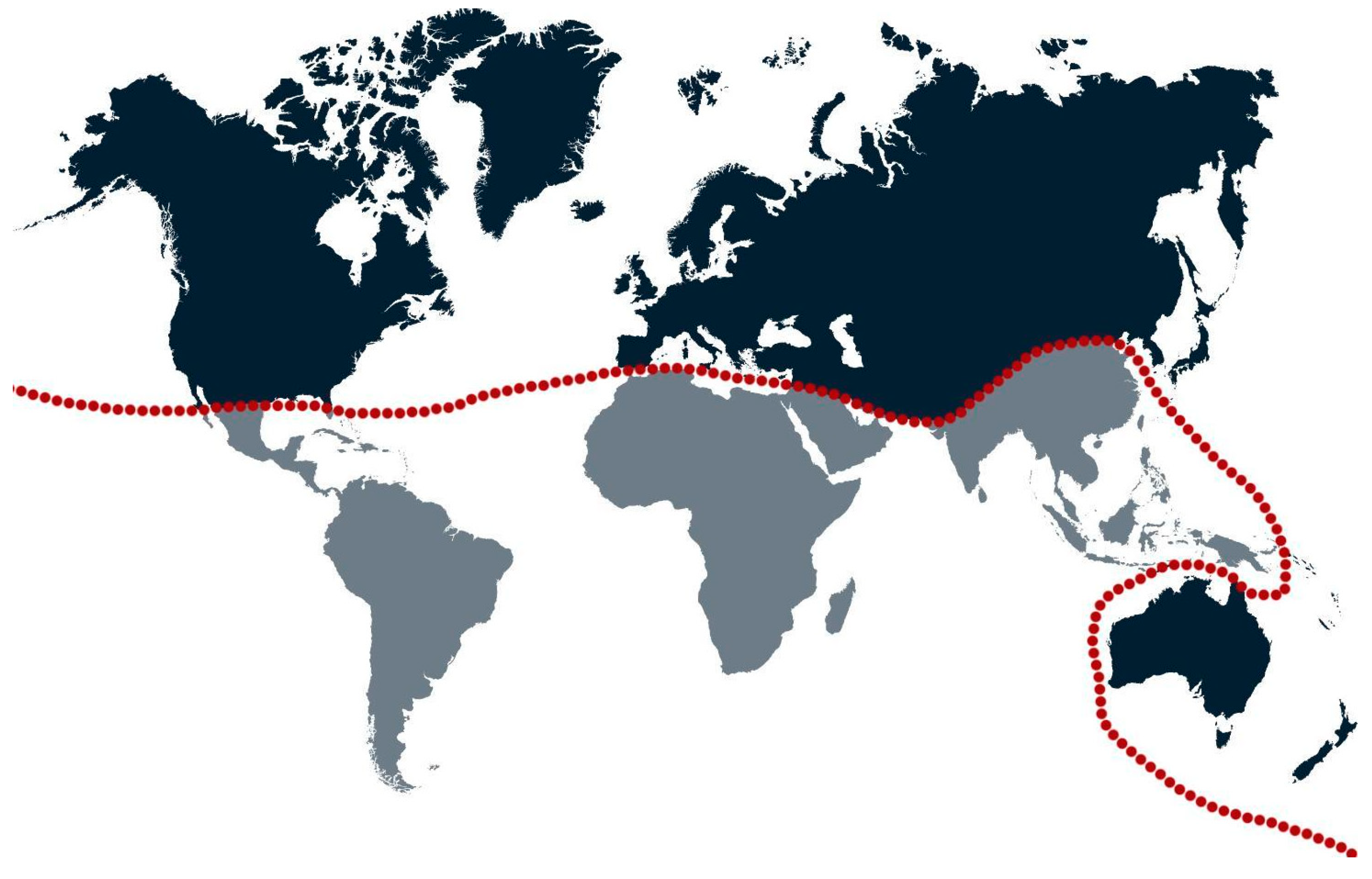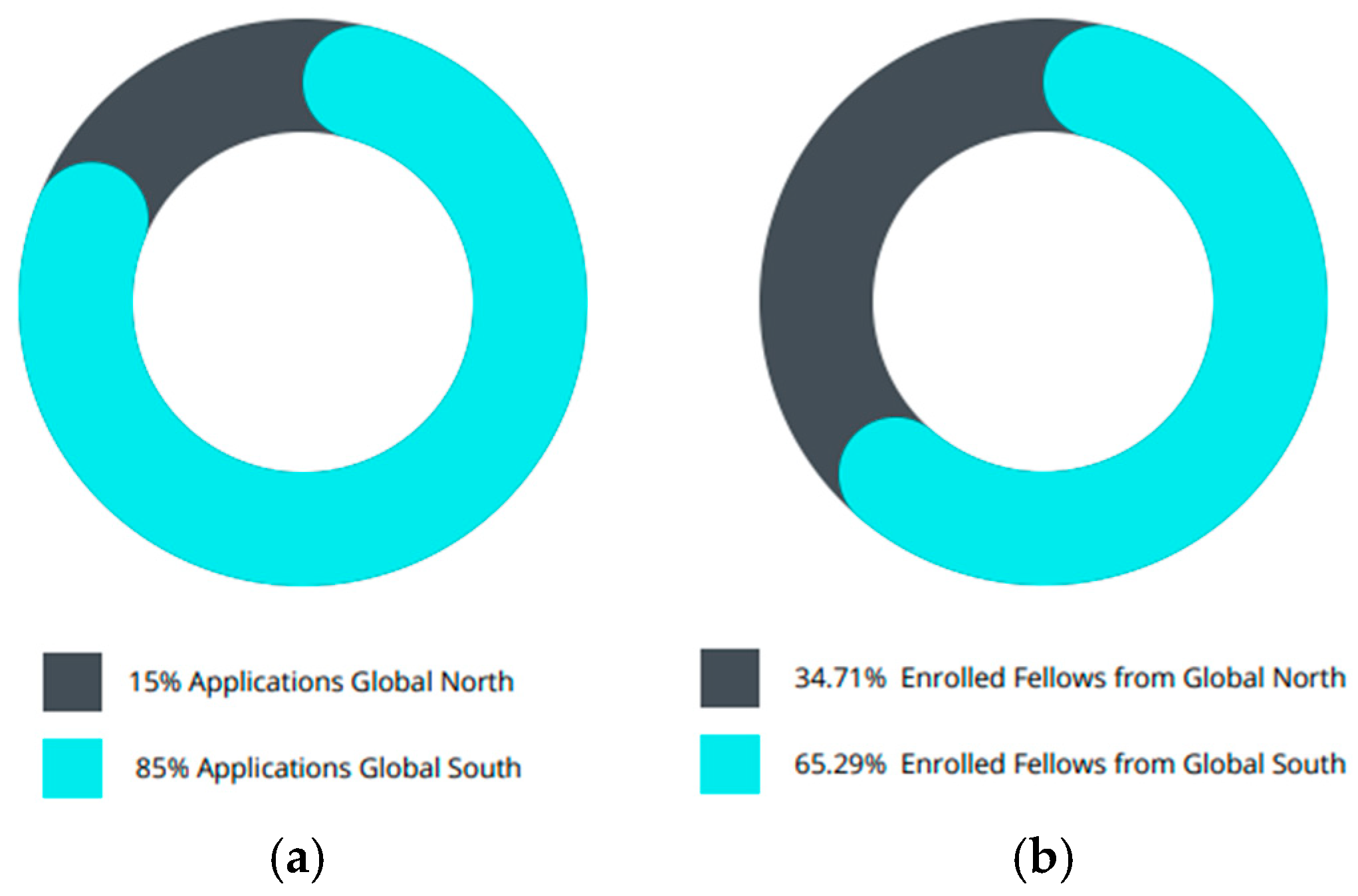1. Introduction
Despite their unfavorable position in the hierarchies of power, young people play a major role in the processes of change taking place in urban spaces [
1]. (For sources on the marginalization of youth, check [
1]). This social group, which is considered precarious, seems then to constitute an effective tool for analysis of politics and of the relations of contestation and domination, and most importantly, of development and change. Youth as a scientific object has been studied through the prisms of international organizations and think tanks that employ the logic of “empowerment”. This logic of empowering young people in most cases has not taken into account the societal configurations of the states from which they come. Therefore, a comparative meso-sociological study that conforms with the theoretical framework of the political sociology of the youth and the political sociology of public actions is needed.
The youth have little influence on the policymaking process as to how their cities are planned and organized. Therefore, the cross-generational aspect of integrating the youth in the policymaking process ensures a sense of belonging and continuity in cities [
2]. SDSN Youth is one of the world’s biggest networks of young leaders working to accelerate solutions towards the Sustainable Development Goals. Its mission is to mobilize youth to shape a sustainable world for future generations. Founded in 2015, the network has expanded rapidly, with 750+ member organizations spreading across 127 countries and four different programs on innovation and entrepreneurship, education, and sustainable cities that have reached 2600 members. It places young people at the forefront of achieving the SDGs.
The Local Pathways Fellowship is one of the four flagship programs by SDSN Youth. The LPF is a 10-month practically oriented training program, designed to enable young fellows to understand the process of localizing SDG 11 at the local level. Through the program fellows analyse the context of their cities and to then develop solutions to their local challenges from ideation to execution.
SDG11 is “Make cities inclusive, safe, resilient and sustainable”. It has 10 targets to be achieved, and this is being measured with 15 indicators. These targets include work in mobility, housing, waste management, green public spaces, and participatory and inclusive planning [
3].
When it comes to SDG11, the literature shows that by 2050, our cities will be home to 70% of the projected 9 billion people. Half of the world’s population today is under the age of 30, with a large majority of them already living or aspiring to live in urban areas, leaving no doubt that the achievement or failure of the Sustainable Development Goals (SDGs) will be determined in cities and that the youth plays a crucial role in this [
4]. Today’s large cities are concentrated in the global south and 60% of the urban growth by 2050 will be taking place in this region [
5].
Over the coming decades, urbanisation will be a defining trend in many parts of the world, especially in East Asia, South Asia, and sub-Saharan Africa, where the bulk of extreme poverty is concentrated [
6].
This paper uses the Brandt Line visualization as shown in
Figure 1 to describe what is referenced as the Global North and Global South.
The ‘Brandt Line’ is a visualization created to illustrate international inequalities and the socioeconomic gulf that separates regions of the world, popularised in North–South: A Programme for Survival—also known as the Brandt report. Snaking across continents to divide the world into the richer North and the poorer Global South, the Brandt Line has for four decades been one of the most recognizable and influential ways of visualizing world politics as shown in
Figure 1 [
7].
2. Materials and Methods
This paper analyses data gathered through the LPF program through its application process, cohorts, and an interactive exercise with fellows.
2.1. Distribution of LPF’s Applicants and Fellows
This section compiles the number of applications received by the LPF between 2018 and 2020 from the global south versus the ones received from the global north. It also showcases the number of fellows that were selected for the program from each region.
The LPF opens a call for applications every year for 6 weeks and invites youth between 18 and 30 who are interested in SDG11 to be part of the LPF. The call is marketed through the LPF’s, SDSN Youth’s, and SDSN’s websites, social media channels, and newsletters. Additionally, the program´s partners and former fellows support spreading the word.
The application consists of completing two questionnaires. In the first one, fellows are asked to outline their motivation to become a Local Pathways Fellow, describe what makes them a good candidate to be an LPF fellow and how their background and experiences can help them become a successful SDG advocate in their city/community, and lastly talk about their vision and role for their city achieving SDG11 by 2030. The second questionnaire consists of submitting a writing sample and 3 videos one where they explain why they want to be part of the fellowship, a second one where they talk about an urban-related project they have participated in, and a last one where they analyse one of the sustainable development challenges that their city is facing and talk about possible solutions.
The selection process consists of a point-based system where fellows are rated based on their qualifications, experience, and proactivity. Secondary scoring criteria are geographical representation, volunteering experience, awareness of SDSN Youth´s mission, and knowledge of SDG11.
2.2. Interactive Exercise
This section consisted of an interactive exercise where 27 fellows were split into groups of 3–4 people. There were groups with all global north residents, others all global south residents, and groups that mixed both. The cities represented in this exercise were Abu Dhabi, Caracas, Celaya, Chennai, Dublin, Ensenada, Gurugram, Hong Kong, Islamabad, Istanbul, Johannesburg, Juba, Lucca, Marseille, Meanjin, Monterrey, Pune, San Pablo Sula, São Paulo, Toluca, Toronto, Warri, and Yantai.
Participants were asked to describe one of their regular commutes including as much detail as possible, such as descriptions of sidewalks, crosswalks, public transportation systems, bus stops, express lanes, toll systems, etc. Then, they were asked to choose one of the commutes from the group and reimagine how it could be better. They analysed and listed approaches that could be taken to improve the commute.
3. Results
3.1. Distribution of LPF’s Applicants and Fellows
Table 1 shows a total of 2810 applications received between 2018 and 2021 where 2390 come from the global south (85%) and 430 from the global north (15%).
Table 2 shows a total of 363 fellows spanning across 4 cohorts, where 237 are from the global south (65.29%) and 126 are from the global north (34.71%).
Applications received by the LPF between 2018 and 2021 show a distribution of 85% coming from the global south and 15% from global north (15%) as shown in
Figure 2.
3.2. Interactive Exercise
This exercise showed that all groups encountered some overlap in the issues that appear in mobility systems regardless of their location. Fellows from different regions mentioned similar problems, including lack of connectivity in public transit systems, and lack of safety for pedestrians and cyclists, and concluded that private vehicles were the safest and fastest mode of transportation. It was agreed that public transport can be improved in most cities and that there are numerous initiatives and much work to be done to achieve sustainable mobility in cities both in the GN and GS.
4. Discussion
This paper found that the LPF program received a much higher number of applications from the global south (85%) than from the global north (15%). This informs us that the demand for free online content and communities in topics related to SDG11 is much higher in the global south, which is where urban growth will ramp up in the coming years.
The ratio of selected fellows reveals 65.29% representation from the global south and 34.71% from the global north. This speaks to more qualified applicants coming from the global north.
5. Conclusions
Youth in the global north has more access to knowledge and content to SDG11-related topics. The number of applications received confirms this presumption by presenting a much higher number of applicants coming from the global south where offerings of this type of content are not as available. This enables the LPF program to capture more applicants from the GS. The number of selected fellows shows that applicants coming from the global north are more likely to secure a spot in the fellowship as they become more informed about SDG11 content and are more likely to count on experience on urban-related projects.
It must be noted that the LPF is receiving this distribution of applications despite the fact that this program is offered in English, therefore limiting the applications coming from the GS to people who are bilingual. The demand coming from the GS would be even higher if the program were offered in languages native to this region. It can be questioned: To what extent can we observe that young people globally regardless of their city of residence share common obstacles and opportunities when implementing an SDG 11-related project?
Keeping this in mind, it is recommended that content produced around urban development best practices is made available in languages native to the GS in order to address the high demand for knowledge on this topic in this region.
Author Contributions
Conceptualization, A.G.Y.V. and E.K.; methodology, A.G.Y.V.; validation, E.K.; formal analysis, N.P.E.-O. and J.S.; investigation, N.P.E.-O. and J.S.; editing, A.G.Y.V. and E.K.; visualization, S.G.; supervision, A.G.Y.V. All authors have read and agreed to the published version of the manuscript.
Funding
This research received no external funding.
Institutional Review Board Statement
Not applicable.
Informed Consent Statement
Informed consent was obtained from all subjects involved in the study.
Data Availability Statement
Supporting data can be found at A Comparative Analysis of the Role of the Youth in Localizing SDG 11 at the Local Level in the Global North and Global South.
Conflicts of Interest
The authors declare no conflict of interest.
References
- Kretsos, L. Union responses to the rise of precarious youth employment in greece: Precarious youth employment and trade unions in greece. Ind. Relat. J. 2011, 42, 453–472. [Google Scholar] [CrossRef]
- Huffington Post, Cities Of The Future: Why We Need Young People To Help Transform Their Communities, Siamak Sam Loni. Available online: https://www.huffpost.com/entry/cities-of-the-future-why-we-need-young-people-to-help_b_580824a0e4b00483d3b5cfc2 (accessed on 1 August 2021).
- United Nations. Resolution Adopted by the General Assembly on 6 July 2017, Work of the Statistical Commission Pertaining to the 2030 Agenda for Sustainable Development (A/RES/71/313); United Nations: San Francisco, CA, USA, 2017. [Google Scholar]
- United Nations. See also General Assembly resolution 50/81 of 14 December 1995 on the World Programme of Action for Youth to the Year 2000 and Beyond (A/RES/50/81) and resolution 62/126 of 18 December 2007. In Policies and Programmes Involving Youth: Youth in the Global Economy—Promoting Youth Participation in Social and Economic Development; A/RES/62/126; United Nations: New York, NY, USA, 2010. [Google Scholar]
- United Nations Department of Economic and Social Affairs. World Urbanization Prospects The 2018 Revision; United Nations Department of Economic and Social Affairs: New York, NY, USA, 2018. [Google Scholar]
- Why the World Needs an Urban Sustainable Development Goal. Available online: https://sdgs.un.org/sites/default/files/documents/2569130918-SDSN-Why-the-World-Needs-an-Urban-SDG.pdf (accessed on 1 September 2018).
- Nicholas, L. The Brandt Line after Forty Years: The More North–South Relations Change, the More They Stay the Same? Cambridge University Press: Cambridge, UK, 2020. [Google Scholar]
| Publisher’s Note: MDPI stays neutral with regard to jurisdictional claims in published maps and institutional affiliations. |
© 2022 by the authors. Licensee MDPI, Basel, Switzerland. This article is an open access article distributed under the terms and conditions of the Creative Commons Attribution (CC BY) license (https://creativecommons.org/licenses/by/4.0/).







